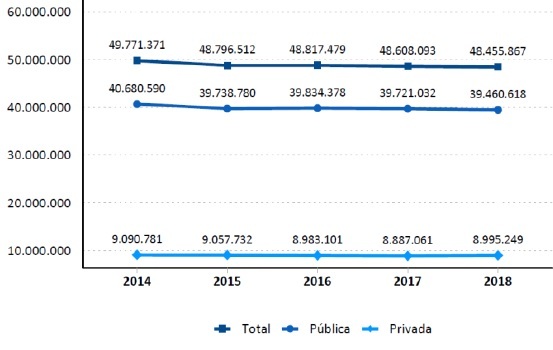The National Institute of Educational Studies and Research Anísio Teixeira (Inep) released this Thursday, January 31, the statistics of the 2018 School Census. The survey identified a drop of 1.3 million in basic education enrollments (kindergarten, elementary, high school and Youth and Adult Education - EJA), between 2014 and 2018.
The School Census is carried out annually and the survey provides an overview of the educational scenario in Brazil, taking into account the public and private education systems. In relation to enrollments, statistics presented by Inep show data from the last five years.
Enrollment
Overall, enrollment in basic education declined year after year, with the exception of 2016, which registered a small increase. In 2014, nearly 50 million children and teenagers were enrolled in basic education. Last year, there were 48.4 million. The drop was 2.6%.

Credit: Inep/MEC
Child education
Enrollments in early childhood education have grown by 11.1% over the past five years, reaching 8.7 million enrolled students. According to the Census, the growth is a result of the increase in entry into day care centers.
Elementary School
Elementary education registered 27.2 million enrollments in 2018, a number 4.9% lower than in 2014. The final years had a bigger drop in relation to the initial ones.
Regarding the fundamental education regime, the Census reported that 9.4% of students are from full-time schools, a quantity lower than the 13.9% in 2017. Public schools are still the majority in the provision of full-time education - 10.9% against 2.2% of private ones.
High school
Secondary education registered 7.7 million enrollments in 2018, a drop of 7.1% compared to the last five years. According to the survey, the reason is the lower entry of students from elementary school and better flow in high school, that is, higher student approval.
Do not stop now... There's more after the advertising ;)
Youth and Adult Education (EJA)
There was also a drop in the number of enrollments in Youth and Adult Education (EJA). According to the survey, 2018 had 1.5% fewer enrollments than the previous year, totaling 3.5 million students.
Professional education
On the other hand, professional education grew by 3.9% compared to 2017. According to data from the 2018 Census, the modalities that grew the most were concomitant and integrated with secondary education, with 8.0% and 5.5% respectively.

Credits: Inep/MEC
Special education
Special Education took a leap compared to 2014, as enrollments grew by 33.2%. According to the Census, the increase was generated by the greater number of students enrolled in high school in this educational modality.
Age Distortion
The Basic Education Census also brings a survey on the so-called "age distortion", that is, when the student is enrolled in a grade that is not expected for his/her age. The data show that the distortion is greater in students in the third year of elementary school, increasing in the sixth and first grade of high school.
The distortion is greater in males, regardless of the stage of education (primary or high school), being the largest incidence in the sixth grade of elementary school: 31% of men older than expected against 19.2% of women.

Credits: Inep/MEC
Other surveys
In addition to data on students enrolled in basic education, the 2018 Census also presents information about teachers and also about schools. O full survey can be checked at this link.
